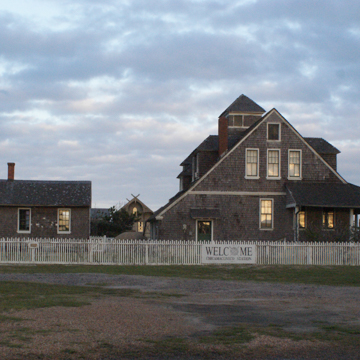The Chicamacomico Life-Saving Station is one of the over two dozen such stations up and down the North Carolina coast. It was of the earliest built in the Tar Heel State and is, today, the most intact.
Lifesaving stations were established by an act of Congress in 1848 as an initiative of the Revenue Marine division of the Treasury Department to provide navigational aids along the seashore. The service was predicated on the notion that small vessels launched from the beach were best suited to safely rescue victims of shipwrecks near the shore. The assumption was that larger vessels approaching shipwrecks from the sea were less nimble and more likely to run aground. Initially established around the greater New York City Harbor and the Massachusetts coastline, early lifesaving stations were unmanned structures for storing rescue equipment and were staffed by volunteers from the surrounding community. They eventually expanded into managed sites by a full-time keeper and seasonal staff. In 1915 the U.S. Life-Saving Service merged with the U.S. Revenue Cutter Service to form the U.S. Coast Guard.
The Chicamacomico Life-Saving Station sits at the easternmost point of land in North Carolina. The complex of buildings extant today evolved from the changing needs of nearly one hundred years of service, and although the complex was relocated from its original site and remodeled several times, it remains one of the most complete and best preserved of these early stations. The present site stretches from Route 12 and the beach just north of Rodanthe on Hatteras Island of the Outer Banks.
The original structure, moved from an earlier location, was built in 1874 and is attributed to Francis W. Chandler, a European-trained architect with the U.S. Life-Saving Service. Today, it sits nearly at the center of the present site and is the easternmost building from the highway. It is a one-story plus attic timber frame building resting on wood posts; the first floor was used for boat and equipment storage and the second floor was originally allocated for dormitory space.
The building features board-and-batten siding with imitated half-timbering, and a gable roof with deep projecting eaves. The first level has a simple finish that contrasts with the more ornamental finish above the chamfered belt course where board ends are cut in a circular pattern and pierced at the center. At the gable end facing the ocean, large double doors open out from the boat room and lead down a ramp on the first level; a pair of pointed arch sash windows with a blind oculus above them completes the second level. The other end of the building has a pair of pointed arch sash windows on the first floor and a rectangular sash window centered above them on the second. Decorative Tudor arches made of wood and terminating the projecting gable roof are supported by open wood brackets that continue around the building sides under deep eaves.
In 1911 a new main building attributed to architect Victor Mendleheff was completed; in 1918 the original station house was converted to a full-use boathouse—today it is referred to as the 1874 building. The 1911 building is presently the largest structure on site and was designed as a variant of the Quonochontaug type stationhouse from Rhode Island. The Shingle Style building is roughly rectangular in shape and oriented east-west. It has a tall sloping gable roof with a lookout tower at one end and dormer windows along both sides. A shed roof supported by white columns covers a single-story porch along the length of the southern side while a small porch centered on the eastern facade below the lookout tower covers an entrance that faces the 1874 building and the ocean.
The Chicamacomico Life-Saving Station was involved in a number of important rescue operations including the Strathairly in 1891, the Fessenden in 1898, and the Minnie Bergen in 1899. The most famous operation performed by members of the Chicamacomico Station was the rescue of the British tanker Mirlo during World War I. On August 16, 1918, the Mirlo was carrying a cargo of gasoline and a crew of fifty-two men on their way to Norfolk when it was torpedoed by the German submarine U-117 off of Cape Hatteras. Captain John Allen Midgett and his crew from Chicamacomico saved forty-two members of the Mirlo with Surfboat 1046. For their heroism, the men were awarded Gold Lifesaving medals by the British Government and Grand Crosses of the American Cross of Honor by the Coast Guard, over half the number that had been awarded up to that point.
During the middle of the twentieth century, the combination of improved boats and the use of helicopters in rescue missions led to the closure of many lifesaving stations. The Coast Guard decommissioned the Chicamacomico Life-Saving Station in 1954 and the National Park Service absorbed the property. In 1968 the Chicamacomico Historical Society obtained the property and continues restoration and curatorial work in the present day.
The station is open to the public from mid-April through November.
References
Bearss, Edwin C., Report on Chicamacomico Lifesaving Station. U.S. Treasury Department-U.S. Coast Guard. Federal Records (Microfilm), Division of Archives and History, Raleigh, North Carolina.
Bishir, Catherine W. North Carolina Architecture. Chapel Hill: University of North Carolina Press, 2005.
Bishir, Catherine W. and Michael T. Southern. A Guide to the Historic Architecture of Eastern North Carolina. Chapel Hill: University of North Carolina Press, 1996.
Noble, Dennis L. “A Legacy: The United States Life-Saving Service.” U.S. Coast Guard Historian's Office. Accessed May 11, 2017. https://www.uscg.mil/history/articles/uslss.pdf
Seapker, Janet K. and Joe Mobley, “Chicamacomico Life Saving Station,” Dare County, North Carolina. National Register of Historic Places Inventory–Nomination Form, 1976. National Park Service, U.S. Department of the Interior, Washington, D.C.
Torres, Louis, Historic Resource Study of Cape Hatteras National Seashore. Denver, CO: U.S. Department of the Interior National Park Service, Denver Service Center, 1985.


